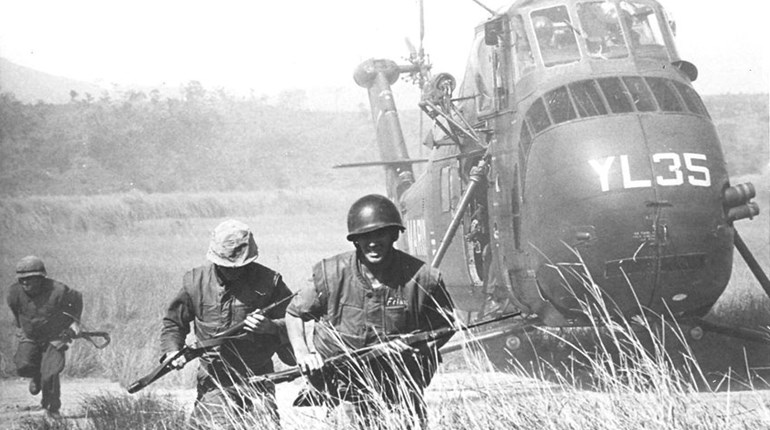
A week very much like this one—a last pinch of August rolling over into September—presents an odd confluence in martial history. Spread over nearly a quarter century, five events and anniversaries in this single week would see a country born; its iconic leader die; a massive, largely unknown migration; and mighty enemies thwarted. In the closing days of World War II, this unknown tropical sliver of coastline, jungle and highlands began a bloody carom through 30 tortured years: Today, we call it Vietnam.

The first event of this eventful week was the birth of the Democratic Republic of Vietnam (Aug. 30, 1945). It marked the end—or so it seemed—of a journey begun a quarter-century before, halfway around the globe.
A well-traveled Vietnamese man born Nguyen Sinh Cung chafed under the French colonial yoke. Finding himself in Paris in 1920, he became enamored by the success of V. I. Lenin and the Bolshevik Revolution in Russia, and traveled there in the mid-1920s. By 1930, he was a dedicated, educated Communist, founding the Indochinese Communist Party in Hong Kong. He was an active agent of the Communist International, or COMINTERN by this time.
In the swift defeat of the French at the hands of Nazi Germany in 1940, he saw a chance to free his Vietnam. The Viet Minh (“League for the Independence of Vietnam”) he founded worked with Chinese support, and helped—at least theoretically—to drive the Japanese from Vietnam. At one time this vast soon-to-be thorn in the side of the United States even received clandestine support from the American OSS, forerunner to the CIA.
The departure of the Japanese created the vacuum Nguyen sought, and with lieutenants Vo Nguyen Giap and Pham Van Dong, he removed the French puppet Emperor Bao Dai in 1945. He assumed the mantle of leadership and declared the DRV on Sept. 2 under the name the world would come to know—Ho Chi Minh, the “Bringer of Light.”
Ho’s apparent liberation of Vietnam did not last. Chinese Republicans and Communists were waging a civil war to the north with complex materiél support implications for Ho, and France had not lost interest in regaining control over the colony.
By 1946, the French and Viet Minh were engaged in an undeniable shooting war—the First Indochina War—that would last nine years. Eventual French “Union” and French-allied casualties would reach 94,000 dead. The Viet Minh would sustain between two and three times that number, and General Giap would begin to earn his reputation for profligate consumption of his own troops.
1950 would be marked by the third event of this memorable week—the arrival of the first U.S. Military Assistance Advisory Group. Principally sent to help the French professionalize the South Vietnamese military, they had some success. A French plan to draw Giap into a decisive encounter far in the northwest ended in disaster, however, and the Viet Minh emerged victorious in the March-May 1954 Battle of Dien Bien Phu. Two months later, at the International Geneva Conference, the French would essentially abandon their claims in Indochina. Like the Korean Peninsula the year before, July 1954 saw Vietnam partitioned into two separate countries—a Communist-controlled North and nominally republican South.
After Geneva, Ho Chi Minh was content to repair war losses and turn North Vietnam into a functioning Communist state. The South was not so lucky: French and Viet Minh agreements in Geneva were not to the liking of any of the powers (mainly the United States and Great Britain) that supported a non-Communist Vietnam. The 1956 re-unification elections planned by the USSR, China (now Communist), North Vietnam and France (now Socialist) were never agreed to or signed by the South Vietnamese or U.S. governments. One article of the Geneva agreement was of intense interest in the South and concern in the North, whether signed or not: A 300-day period during which citizens could relocate to the other side of the 17th parallel.
One article of the Geneva agreement was of intense interest in the South and concern in the North, whether signed or not: A 300-day period during which citizens could relocate to the other side of the 17th parallel. Beginning in September 1954, more than 1 million Northerners came south (and another 2 million may have been improperly restrained from doing so).
This largely unknown phenomenon may have had a larger impact on the subsequent conflict than is readily apparent. It created problems for President Ngo Dinh Diem: Most of those fleeing the North were Roman Catholics, as was Diem. Many resettlement efforts by the Diem administration appeared to favor Catholics, and this only added to the perception that other parts of Diem’s government had integrity problems of the same sort. As unrest grew, so did renewed combat with the North, particularly through Viet Cong insurgency.
Then, in June 1963, a senior Buddhist monk immolated himself in a horrifying act of protest on the streets of Saigon. More missteps followed, including poorly disguised retribution by Diem supporters against religious sites and the arrest or harassment of hundreds of monks and thousands of other Buddhists.
By October, American Ambassador Henry Cabot Lodge Jr. and Ambassador-at-Large Averell Harriman at best stood aside, and at worst facilitated, the assassination of Diem. A series of coups d’etat would follow, resulting in damaging instability at least until late 1965, when Army General Nguyen Van Thieu emerged as the new leader of South Vietnam.
The final event can perhaps be deduced—the Sept. 2, 1969, death of Ho Chi Minh. Any look at Ho in this context reveals a quixotic, complex figure. Much after 1965, ill health left the prosecution of his war against “the imperialists”—any imperialists—largely in the hands of others, which may in turn explain many things. The savage prosecution of the Tet Offensive against civilians in Hue, for instance, or abuse of POWs are just two examples that may not have accorded with his wishes and morals.
Rehabilitative biographers and historians argue that “Uncle Ho” was thrown into the arms of Russian and Chinese Communists because multiple U.S. presidents ignored both his posited admiration for the Declaration of Independence and Constitution, and his frank pleas for out-and-out assistance.
As some of those communications actually exist, his entreaties can’t be denied. But there are other episodes, just as verifiable and troubling: Elimination of opponents, alliances of convenience and betrayals were numerous, too. His wars, however justified he may have believed them, claimed nearly 3 million lives (including 58,286 Americans). His successor’s peace claimed another 165,000.
Then, of course, there’s this from the man himself: “Anyone who does not follow the line determined by me will be smashed.”


































